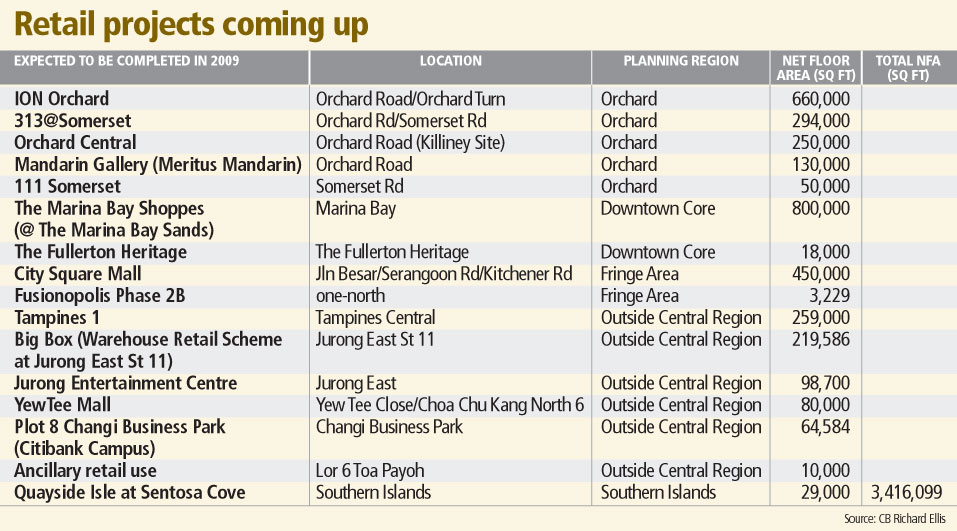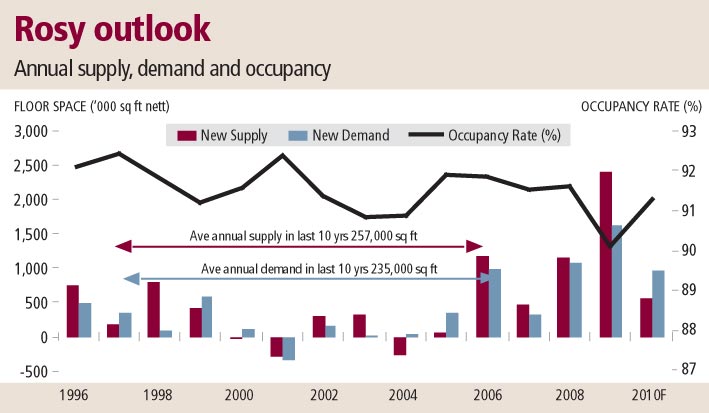|

 
Retailers,
landlords lock horns
Retailers
want rent cuts as income has contracted 20-30% but landlords argue not all
have been hit equally
Hit by
weak sales and high rents,
Singapore's retailers are bleeding - and they want landlords to help them
out by cutting rents. But landlords are saying that rent cuts of 20-30 per
cent all round - which is what the Singapore Retailers Association (SRA)
publicly called for last week - are neither needed nor feasible. Instead,
building owners are looking at ways to help tenants with sales. 'Rent is
always a function of sales. Therefore, the most scientific way to look at
sustainable rent for each trade is to look at each retailer's occupancy
cost,' said Lim Beng Chee, chief executive of CapitaLand's retail arm.
CapitaLand, which owns and/or runs 16 malls, is Singapore's biggest retail
landlord.
Typically, landlords calculate
occupancy cost as rent divided by gross revenue. For CapitaLand's retail
trust CapitaMall Trust (CMT), the average portfolio occupancy cost was
about 16 per cent in 2008. Most tenants' occupancy costs fall within the
15-18 per cent range, according to CapitaLand.
Frasers Centrepoint, which has seven
shopping malls, says it has been meeting tenants to work out solutions
based on what their specific or critical needs. 'Outright rent rebates are
not a sustainable option given the tight profit atmosphere that every
business is currently operating in,' said a spokesman.
At the Causeway Point and Anchorpoint
malls operated by listed Frasers Centrepoint Trust (FCT), the respective
average occupancy cost was 12.7 per cent and 15.7 per cent in 2008. But
the average occupancy cost at a mall cannot be applied across the board to
all tenants. For instance, a supermarket with a much smaller profit margin
will not be healthy within the average range, while other trades - such as
accessories, fashion and cosmetics - can afford higher occupancy costs
because they have better margins. Most developers, therefore, fix rents on
a case-by-case basis.
SRA says retailers' income has
contracted 20-30 per cent in the past few months, but landlords say not
all retailers have been hit equally - so they are not willing to drop
rents for all tenants. 'The financial crisis is not hitting all malls
equally. Most of our malls are still showing healthy numbers, both in
sales, traffic and occupancy costs,' said Frasers Centrepoint.
Landlords say they monitor tenants'
sales closely and can easily tell when a tenant is in serious trouble.
CapitaLand, for example, evaluates tenants' sales and occupancy costs on a
monthly basis - store by store and trade by trade - using a system that
captures data at each tenant's point-of-sales. The data is then uploaded
into a central database, often daily. Mr Lim, therefore, is confident that
the company will be able to spot tenants that are in real trouble and help
them accordingly.
But retailers say landlords can never
really understand what is happening on the ground. A spokesman for RSH
said: 'Should landlords be defining what is viable for their tenants?
Every tenant has a level of profitability they have to achieve to sustain
their business, and that level varies from retailer to retailer. Each
label or retail concept works with a margin and cost base, and that varies
even for brands within the same category. Would landlords have the
knowledge or information on these margins and costs, which is
information-privy only to retailers themselves?'
Retailers are also frustrated that
landlords still seem to be 'waiting' and 'assessing' the situation -
instead of acting to stop the slide. They say that instead of taking the
bold and necessary step of cutting rents, landlords are trying to help
tenants manage their occupancy costs in other ways - which, according to
them, are not working on the ground.
Frasers Centrepoint, for one, said it
has stepped up advertising and promotions (A&P) for its malls. 'We
have increased our expenditure about 10 per cent to focus on more tactical
promotions we feel will help increase tenant sales,' the company said.
Likewise, Mr Lim said CapitaLand has in
place a slew of measures it can activate to help its tenants. These
include relocation to a higher floor within a mall where rent is cheaper,
downsizing store space and to trying to boost gross revenue through
promotions such as push sales in atriums.
The last strategy - giving discounts
and holding promotions to increase revenue - is already common as
retailers try to prop up revenue artificially to pay their rents and
improve cash flow. But in the long run, this strategy is not sustainable,
tenants say.
'The formula (rent/gross turnover) is
such that retailers have to generate sales even when the market is bad,
and many resort to more discounts and more promotions. So even if the
turnovers increase, margins fall,' said Douglas Benjamin, chief executive
of retail group FJ Benjamin. 'Just looking at occupancy costs is not
accurate when it comes to measuring the health of a tenant. You have to
look at the margins as well.'
And there is no doubt that margins are
being hit. FJ Benjamin says that for the industry as a whole, margins are
down 20-30 per cent. SRA also said last week that retail margins are now
almost negligible - if not negative. Increased A&P expenditure will
not help much at a time when the entire market is depressed, one retailer
told BT.
And landlords, retailers complain, are
not just refusing to cut rents - they are, in fact, looking to increase
rents about 20 per cent when the time comes for leases to be renewed. When
talks on lease renewal for his Mothercare store at VivoCity began, the
mall began by asking for 22 per cent more, Pang Kim Hin, chairman of the
baby goods retailer, told BT. His story is just one of many such
complaints from tenants in recent weeks.
Landlords maintain that they are only
asking for the kind of rent increases that tenants can afford to pay. In
2008, Frasers Centrepoint renewed 27 leases at rents that were on average
17.5 per cent higher than preceding rates. And CMT said 363 new and
renewed leases were signed in 2008, at rents 9.3 per cent higher than than
preceding rates. Typically, preceding rental rates were committed about
three years ago. Many landlords, which are listed companies, also point
out that retail rents are their only sources of income. CMT, for example,
reported gross revenue of $511 million in 2008. If the retailer were to
cut rents 30 per cent across the board, revenue could fall by an estimated
$153 million. This means that the trust's distributable income, which was
$238 million in 2008, could fall to just $85 million - something that is
sure to upset the trust's international institutional investors.
The same applies for other
Singapore-listed retail trusts such as FCT and Suntec Reit. Cutting rents
and, consequently, distributions by significant amounts is akin to sending
a signal to international investors that Singapore's economy is in dire
straits, a reit manager said.
Frasers Centrepoint explained: 'As with
any business in this economic climate, we are also subject to a similar
predicament. The costs of doing business has affected landlords as well,
with borrowing costs having increased substantially.'
In light of all this, some landlords
say not all businesses can or should be saved during a downturn. 'In cases
where the tenants have over-expanded or if their business model or product
is not sustainable, the most logical and win-win solution for us is to
facilitate an amicable way to pre-terminate the leases to prevent further
losses to the tenants,' said CapitaLand's Mr Lim, adding that the
developer takes this approach during good times and bad.
- 2009 March 5 BUSINESS
TIMES
Prime retail rents to slip 5-15%
New retail space of 3.4m sq ft available in '09, and spending slowdown

Retail landlords
are headed for a rough patch as consumer spending weakens amid the economic
downturn and with 3.4 million sq ft of new retail space scheduled for
completion next year, property consultants say.
Knight
Frank's head of retail Sherene Sng predicts that average rents for prime
retail space in Orchard Road and at suburban malls could slip 5-15 per cent
in 2009. 'For super-prime retail space on Orchard Road, the decline, if any,
will be capped at around 5-10 per cent at most, because there's not that
much super-prime space around and most of it is in malls that are very well
managed,' she said.
For
full-year 2008, Ms Sng expects retail rents island-wide to be pretty much
flat, increasing no more than 5 per cent.
CB
Richard Ellis said yesterday retail rents stagnated in the third quarter of
this year, and trimmed its full-year 2008 forecast for prime Orchard Road
rents.
It
now expects Orchard Road rents to edge up 2-3 per cent in 2008, lower than a
3-5 per cent increase it predicted earlier this year. However, CBRE is
maintaining its 3-5 per cent increase forecast for prime suburban mall rents
in 2008, due to the captive market of HDB heartland shoppers these malls can
count on, as well as limited new supply of retail space in the suburbs.
Some
41 per cent of the 3.4 million sq ft of new retail space slated for
completion next year will be in the Orchard Road belt - coming from
developments like ION Orchard, Orchard Central, 313@Somerset
and Mandarin Gallery.
'This
will bump up total private Orchard Road retail stock some 36 per cent in
just 2009 alone and undoubtedly raise concerns about space absorption,
despite the fact that retail take-up tended to be somewhat supply-led in the
past,' CBRE said.
The
biggest contributor to new retail space on the island next year will be The
Marina Bay Shoppes at Marina Bay Sands, with 800,000 sq ft of net lettable
space, according to CB Richard Ellis. The Downtown Core region, where the
development is located, will account for 24 per cent of new retail space
being completed here next year.
Knight
Frank's Ms Sng says the big factor affecting retail rents next year will be
not so much the completion of 3 million-plus sq ft of new space but a
slowdown in sales as people tighten their belts and cut spending due to the
economic downturn.
'This
will cause retailers to become more cautious and adopt a watch-and-wait
attitude and hold back business plans,' she said. 'Some smaller retailers
operating as sole proprietorships or partnerships may also be affected by
the stockmarket crash. Of course, there will be some retailers that are
still doing well - but they too will use the weaker economic climate to
secure more attractive rents from landlords when they renew leases or open
new stores.'
CBRE's
data shows that in Q3 2008, the average monthly prime retail rent in Orchard
Road was $36.80 per sq ft, while the average super-prime rent there was
$54.40 psf. The average prime retail rent in the suburbs was $29.30 psf. All
three numbers were unchanged from Q2.
CBRE's
director (retail services) Letty Lee declined to forecast retail rents going
ahead. 'A number of factors will determine the rate of rental change for the
rest of this year and the next,' she said.
'The
full impact of the financial meltdown on the job market is still unknown. In
the meantime, consumers will remain cautious and may cut spending as a
result.
'The
financial turmoil will also affect tourism, which will in turn affect
consumer spending. Landlords may be pressured to reduce rents as a result.
We are still assessing the situation and it is difficult to make a
projection at this stage.'
Colliers
International said in a report yesterday that while year-end festivities may
provide some relief for retailers, consumer spending is likely to remain
subdued given the poor economic outlook and the drop in foreign visitors.
Any
retail rental growth is therefore expected to be minimal in the last quarter
of the year. 'As such, rents are projected to increase by up to 5 per cent
for the whole of 2008,' Colliers said.
- 2008 October 24 BUSINESS
TIMES
Retail property market remains stable in Q2: DTZ
Turnover rents
rise; limited growth for fixed gross rents
Buoyed by positive consumer sentiment and
the Great Singapore Sale period, the retail property market remained stable
in the second quarter of this year, according to a market report by real
estate consultancy DTZ.
Turnover rents in Q2 rose, but there was
limited growth for fixed gross rents. DTZ noted that tenants were 'resisting
committing at higher rents for both new retail space and lease renewals'.
First-storey monthly fixed gross rents
remained largely unchanged quarter on quarter, hovering at an average of
$42.40 per square foot (psf) for prime areas such as Orchard/Scotts Road,
$33.70 psf in suburban areas and $27.10 psf in other city areas.
The retail market is expected to remain
stable, despite competition from additional supply that will come on stream
over the next few years. Malls such as ION Orchard, Orchard
Central and 313 @ Somerset are slated for completion by 2009.
As much as 5.4 million square feet of
retail space will be added to the mix between the second half of this year
and 2012. Marina Bay Shoppes by developer Marina Bay Sands will account for
the biggest chunk of that space, with 15 per cent or 800,000 sq ft, closely
followed by CapitaLand and Sun Hung Kai Properties' ION Orchard at 663,000
sq ft. - 2008 July
3 THE
BUSINESS TIMES
 
Retail rents rise in Q3 but retail sales
at a high
Rents for shops on Orchard Road may have
increased by another 12 per cent in the third quarter to $44.30 per square
foot (psf) per month, but retailers are unfazed, especially as the latest
figures show that the second quarter of this year saw the strongest sales
for 10 years.
According to a report by property
consultancy Knight Frank, retail sales value (excluding motor vehicle sales)
in the second quarter hit a 10-year high of $8.15 billion.
The figure for the quarter was also an
improvement on the previous interim high of $7.8 billion seen in the final
quarter of last year.
Not surprisingly then, rising rents in
the Orchard Road vicinity as well as the Marina area, where rents increased
by 3.7 per cent quarter-on-quarter (q-o-q) to an average $28.90 psf per
month, are not upsetting retailers too much.
Knight Frank director (research and
consultancy) Nicholas Mak says: 'With the planned revitalisation of the
Orchard area, retailers are optimistic that their retail sales figures are
able to offset the increase in rentals.'
Knight Frank also expects full year
figures to hit a record high, pointing out that at end-July 2007, total
sales figures already stand at $18.4 billion compared to $29.5 billion for
the full year of 2006.
Nash Benjamin, the CEO of FJ Benjamin,
which owns Guess, Gap and Celine here, has noticed that rents have been
rising but he says: 'The bottom line is whatever rental you pay must finally
be relative to the business, otherwise tenants will not be able to invest.
We are fortunate that most malls we work with have a good understanding of
this principle.'
With space getting more expensive,
retailers are becoming more sensitive to rentals on a per square foot basis
too.
Steven Goh, spokesman for the Orchard
Road Business Association, believes the situation is not so much that
retailers are prepared to pay higher rents for a prime space but more that
they have become more savvy in measuring how 'productive' their businesses
are.
'For instance, a restaurant that was
2,500 sq ft before may streamline its operations to 2,000 sq ft because it
gives the optimum return of $100 worth of sales on a per square foot basis,
which can justify the rental,' he explains.
Another example Mr Goh gives is that of
fashion boutiques, which on average, must make between $120-$150 psf in
sales. And the concern is not so much about rent. 'The pressure is actually
to find new concepts,' he says.
Perhaps a sure sign that retailers and
their landlords are doing well is when a shop decides to expand, even when
rents keep rising.
High-end leather goods retailer Tod's, in
the equally high-end mall Paragon, has just moved into bigger and better
premises with frontage on Orchard Road, increasing its store size by about
50 per cent.
Patrina Tan, deputy general manager of
marketing at Paragon, says it does not discuss rents but does concede that
all landlords do see the expiry of an existing lease as an opportunity to
review rent levels. 'Rentals are always relative,' she adds.
She also reports that the sentiment among
the tenants at Paragon is definitely 'positive'.
The outlook for the future remains good
too despite close to 2 million sq ft of retail space scheduled to be
completed by next year. And at Knight Frank, Mr Mak says he does not expect
demand to decrease either.
For the rest of the year, Knight Frank
expects occupancy to increase by about one percentage point q-o-q. This will
bring islandwide occupancy to between 93 and 94 per cent and Orchard Road
occupancy to about 95.8-96.5 per cent.
Knight Frank also expects rentals for
prime retail space to increase 15-20 per cent year on year, with capital
values rising by 10-15 per cent. -
2007 October 9 SINGAPORE BUSINESS TIMES
|